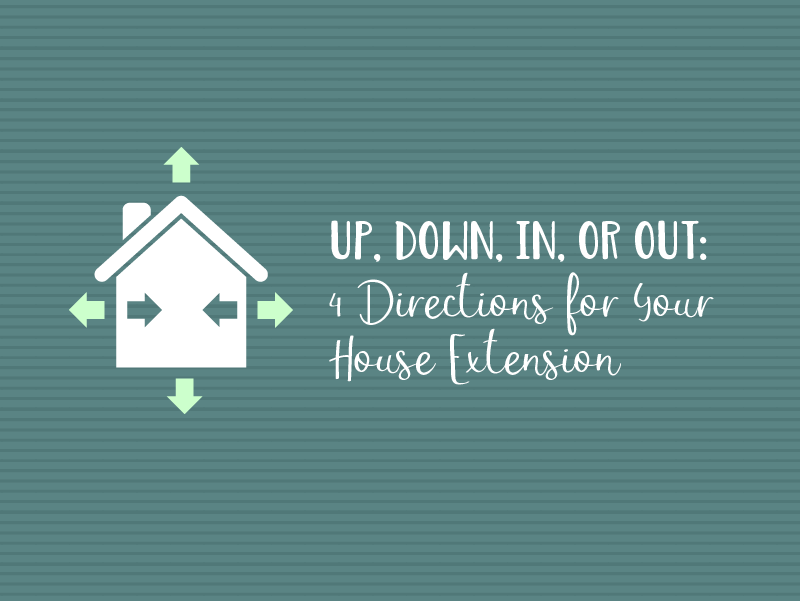Ever get that eerie feeling that your house is… shrinking?
You’re not the only one. If you bought your house as a young couple and watched your family grow, it may feel like lately, we’re finding that the house is a little smaller than it used to be: it’s not filled with children, friends, toys, pets, and all the objects we accumulate with time.
And that’s ok, that’s life.
But what if you want to regain a little space for yourself? Well, you could move. But moving is expensive, and if you love your home and your neighborhood, that option is off the table.
The better option is extending your home – it’s a great way to increase your living space.
Thinking about what kind of space you need will help you determine what kind of extension best suits your family – and which direction you should extend in!
Up
If you want a little more space, but you don’t have the room to extend outwards into your yard, or you just don’t want to lose your outdoor space, going up is a great way to go.
That extra space is perfect for separating living spaces from bedrooms, or for adding a granny flat for guests, offering you a little more privacy. It may also be a great idea to extend up if you have great views you can capitalize by adding another floor.
A second-floor extension can be added to many different types of houses. It might even be cheaper to extend up rather than down because there’s no need for expensive foundations or preparation work on the ground.
You may even think of transforming your downstairs to an open-plan space and to group your dining and kitchen areas together.
You’ll lose a little space on the ground floor for stairs, and of course upward extensions aren’t suitable for all houses, but we think it’s a great way to create more space.
And an extra bonus: real estate markets can be hard to predict, but houses with two floors often have a higher resale value.
Extend up for: Attic conversions, children’s or extra bedrooms, home offices, granny flats, additional bathrooms, balconies, roof gardens.
Down
Extending downwards is another great way to create more living space for your family without affecting your outdoor space. It’s not always possible for our neighbors in southern states, where high water tables make it too cost-prohibitive to extend downwards, but up here in Oregon, many home renovations are basement conversions.
If you have an unfinished basement, you can exploit that space and turn into extra habitable space. You may even be able to extend downwards by creating a basement.
With the right kind of insulation, basements can be warm and cozy, a quiet little refuge. Finished basements often increase your home’s value.
To keep it within budget, you could keep the renovation work to simply creating a little more space in the basement as a kitchen cellar or pantry. You might not even need planning permission, though your construction company will evaluate the extension design plans for structural integrity.
Extend down for: Dens, home offices, children’s playrooms, guest rooms, extra bathrooms, kitchen pantries, wine cellars.
In
When looking to add space to your house, you might not initially think of looking in, but reconfiguring the layout of your house to create more space is often an overlooked and inexpensive renovation, compared to full extensions.
Renovating internally could let you make the most of natural light, add a little privacy, enhance your views, give you a little more space, and improve access.
You could remove internal walls and door – or add them – to get the look you need and integrate a new extension. Some houses with high ceilings are great candidates for creating a mezzanine or split-level space, while others can accommodate raising the ceiling so the room feels bigger or creating vaulted ceilings into the attic.
These renovations can be very affordable compared to digging down or building up. They’re also a great way to add structural visual interest to the inside of your house.
Extend in for: Mezzanines, bedrooms, open-plan designs, entertainment spaces, extra storage, visual interest.
Out
Like the upwards extensions, outdoor extensions are extremely popular and add an enormous amount of space. They often add value to your house, too!
While you may lose a little outdoor space, how much is entirely up to you. Extending out is a great way to personalize space because you can truly create an extension that’s highly personalized and can be adapted to so many different uses.
The possibilities are endless: Add an open-plan kitchen extension to cook to your heart’s desires, a living or dining room extension to entertain, an extra den for the teenagers in your life, a cozy home office with great views, or an extra closed-room bedroom for guests.
If you’re in Oregon like us, outdoor extensions like sunrooms and conservatories can provide a cozy way to get more use of your garden and the sunlight in winter. And with the amount of snow we have in Oregon, garages connected to the house are always popular to protect us from the elements as we bring the kids and groceries in and out of the car.
Extend out for: Front porches, home offices, sunrooms and conservatories, sheds and garden rooms, kitchen and living room extensions, garages, “she-sheds” and “man-caves”.
Extending your home in any direction can seem a little intimidating, but we have great news for you: we can help with every step of the way, from the dreams and design to the construction and completion.
Feeling like you could use a little more space? Let us help you create it: give us a call at Keith Green Construction.

